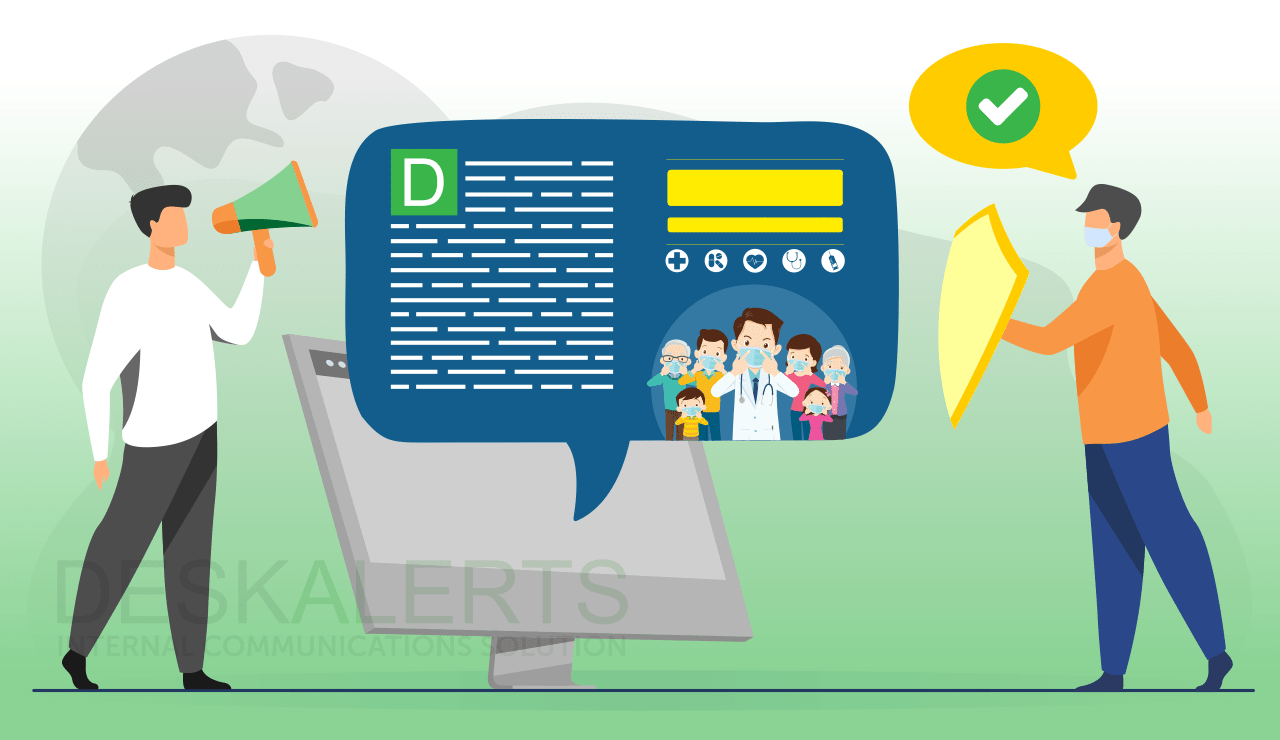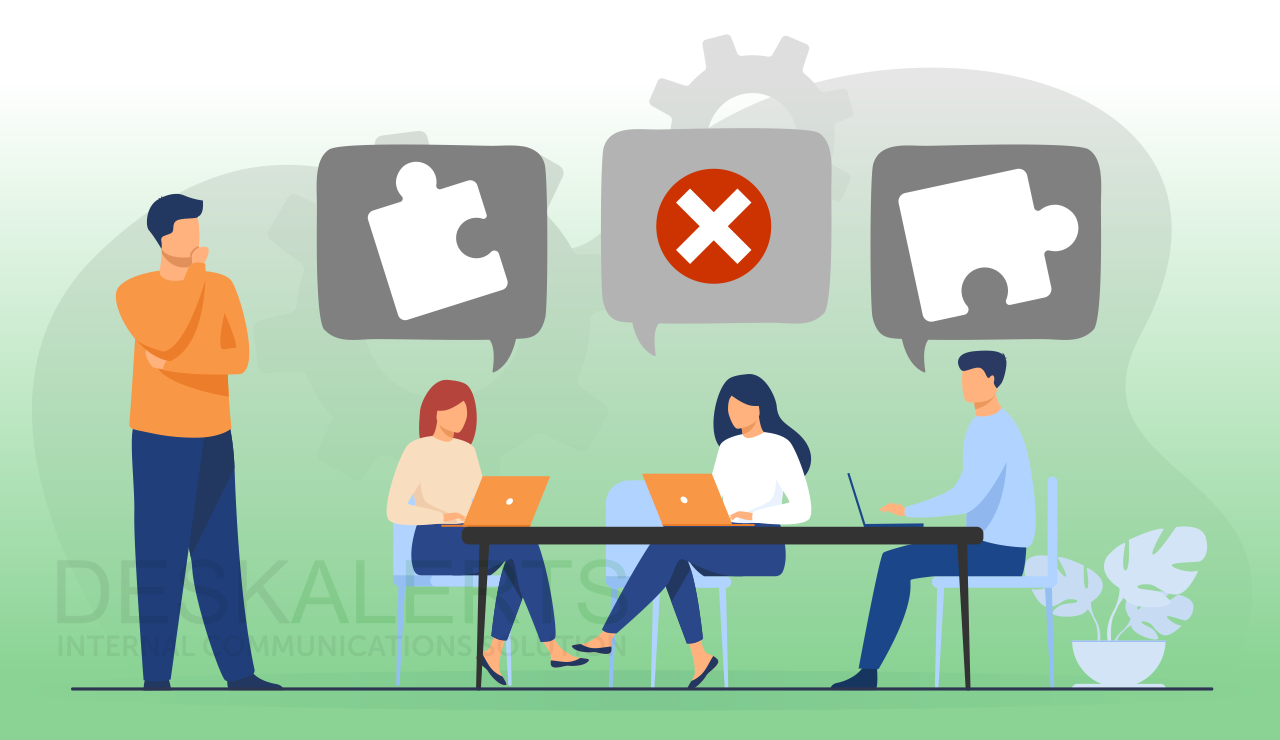
Building a safety culture in your organization, where employees understand what procedures they must take to be safe and how to report any hazards should be one of your top priorities. Not only will a safe workplace help to keep your employees motivated with high levels of morale, there are many benefits to the organization as a whole to do this.
A Liberty Mutual Workplace Safety Index report found that every $1 that companies invest into safety in their workplaces, they achieve a $4 return on investment.
This is achieved through lowered workers’ compensation claims, less time lost, greater efficiencies, savings on legal costs, etc. One of the most effective ways to achieve this is to communicate well and to communicate regularly with your employees about safety expectations in the workplace. Simply put, this means you need to send work safety messages to employees.
Table of contents
How to write a safety message?
How to motivate employees to work safely
Examples of the types of safety messages to employees you can create
Safety messages to employees from the CEO
How to deliver your safety messages
How to write a safety message?
When creating safety messages for work, the following points should help guide you:
- Keep your messages short. Long items of communication may not get read all the way through.
- Keep your information simple. If you over-complicate your messaging or use jargon, people won’t understand what you need them to.
- Keep your information relevant. If your employees work in an office and don’t operate heavy machinery, there’s no point in giving advice on operating heavy machinery! Promote situational awareness and get your employees to be on the lookout for specific and relevant risks.
- Make your messages memorable. You might want to get creative and play with words and expressions in a way that employees will remember. This might include metaphors, or puns, or other interesting writing methods.
- Write using positive language. Focus on the types of behavior you want to see in the workplace when it comes to safety, don’t dwell on the negative.
- Get visual where you can. If you can accompany your safety message for work with visual imagery it can make your words more impactful.
How to motivate employees to work safely
Companies often find it difficult to keep employees motivated when it comes to workplace safety. There are a few key ways to engage your employees on this topic and make them want to take action:
- Create slogans. Catchy and short safety messages that help define your objectives are likely to resonate and stick with employees.
- Create visual displays. People react better to information when it is presented visually and are more likely to retain it.
- Offer encouragement to do the right thing. Employees are more likely to react more favorably to positive reinforcement such as praise, rewards and recognition. Work practices such as discipline don’t motivate people and can severely impact morale.
- Involve your employees in the process. When you include employees in the process of improving workplace safety, it enables them to feel connected to the project and its outcomes. Let them be involved in purchasing protective equipment, participate in committees, contribute suggestions and ideas.
- Change it up. Keep safety front of mind by sending regular safety messaging, for example, daily safety messages that appear on computer login screens – e.g “a safety message for today”.
SAFETY MESSAGE OF THE DAY EXAMPLES FOR YOUR WORKPLACE
A generic safety message to employees such as “be safe” or “mind your step” or “be aware of your surroundings” on paper might seem like a good thing to communicate with employees, but the reality is they are so bland that they are often unnoticed. By taking a more creative approach – either by using clever words, humor or inspirational quotes about safety – your messaging will be more engaging and is more likely to get the cut-through that you seek.
HERE ARE SOME “SAFETY TIP OF THE DAY” IDEAS TO TRY IN YOUR COMPANY
- “There are no dumb questions, but lots of dumb mistakes. If you’re not sure, ask!”
- “Safety brings first aid to the uninjured.” – F.S Hughes
- “Safety is not an accident.”
- “Safety is the seam that joins life’s fabric. Don’t let loose threads bring it undone.”
- “Carefulness doesn’t cost anything. Carelessness could cost your life.”
- “Your first mistake might also be your last.”
- “Wearing a mask is better than wearing a ventilator.” (COVID-19)
- “Safety is something that happens between your ears, not something you hold in your hands.” – Jeff Cooper
- “Shortcuts could cut your life short.”
- “Luck runs out, but safety is good for life.” – unknown author
- “Spills and slips might lead to hospital trips.”
- “Cover your face and give people space.” (COVID safety message)
- In the midst of chaos, there is also opportunity.” – Sun Tsu
- “When you’re not safety conscious you might end up unconscious.”
- “Safety: what you forget can lead to regret.”
- “Safety starts with awareness – stay vigilant!"
- "Report hazards promptly to ensure a safe environment."
- "Protect your hands, they're your most valuable tools!"
- "Safety is a team effort – look out for each other."
- "Proper lifting prevents back injuries – use your brain AND your legs!"
- "Safety glasses on, accidents gone – prioritize your eye protection."
- "Emergency exits are not just for drills – know your way out."
- "Stay hydrated – a healthy worker is a safe worker."
- "Don’t be a fool - inspect your tools before use for optimum safety."
- "Electrical safety first – faulty equipment can be shocking."
- "Safety is a full-time job – not just when it's convenient."
- "Hearing protection: your ears will thank you later."
- "Mind the step – watch where you're walking."
- "Safety rules are your best tools – follow them."
- ""Stay alert, stay alive – focus on the task at hand."
- "Take regular breaks to maintain focus and prevent fatigue."
- "Always wear your seatbelt – on the road and at work."
- "Emergency drills save lives – know what to do!"
- "Don't rush – speed puts safety at risk."
- "Safety is an investment, not an expense – prioritize it."
- "Stay calm in emergencies – panic hinders quick thinking."
- "Follow our caution signs and know the potential dangers."
- "Safety gear is your shield – wear it with pride."
- "Maintain good housekeeping for a safer workplace."
- "Stay well-rested – fatigue impairs judgment."
- "Inspect fire extinguishers regularly – be prepared."
- "Lockout/tagout procedures save lives – follow them."
- "Safety is a culture, not a task – embrace it."
- "Stay in designated areas – unauthorized zones may be hazardous."
- "Keep aisles clear for smooth evacuation if needed."
- "Report near misses – one day they could be the real thing."
- "Wear appropriate footwear for your job."
- "Breathe easy! Proper ventilation is key – don't ignore air quality."
- ""Use caution when handling hot surfaces or materials."
- "Emergency numbers should be visible and known to all."
- "Communication is crucial – keep channels open about safety concerns."
- "Inspect scaffolding before use – safety at heights matters."
- "Stay mindful of ergonomics to prevent strain injuries."
- "Safety is not negotiable – shortcuts can lead to accidents."
- "Be aware of your surroundings – situational awareness saves lives."
- "Never remove safety guards from machinery."
- "Don’t get caught out. Check expiry dates on safety equipment regularly."
- "Properly store and label chemicals for easy identification."
- "Safety meetings are essential – participate actively."
- "Adapt to changing weather conditions – dress accordingly."
- "Always use the right tool for the job."
- "Use caution when operating machinery – follow procedures."
- "Protective clothing is a must – wear it consistently."
- "Emergency lighting ensures a clear path in case of power failure."
- "Stay organized – clutter can lead to accidents."
- "CPR training can make you a workplace hero – get certified."
- "Mind your posture – ergonomic setups reduce injuries."
- "Inspect fire alarms monthly like your life relies on it."
- “Don’t be a fool with power tools – follow safety guidelines."
- "Watch out for electrical cords – avoid tripping hazards."
- "Stretch before physical tasks to prevent strains."
- "Avoid distractions when operating heavy machinery."
- "Personal protective equipment is non-negotiable – wear it!"
- "Secure ladders properly before climbing."
- "Mind your step on wet or slippery surfaces."
- "Emergency response plans should be visible and understood."
- "Make sure you can be seen! Wear high-visibility clothing in appropriate areas."
- "Sprinklers matter. Regularly inspect fire sprinkler systems."
- "Report malfunctioning safety equipment immediately."
- "Stay updated on first aid procedures - your colleagues may thank you."
- "Be mindful of noise levels – use hearing protection as needed."
- "Avoid overloading electrical outlets – prevent fires."
- "Keep chemicals away from food preparation areas."
- "Ensure emergency exits are well-lit at all times."
- "Be cautious when handling sharp objects."
- "Replace worn-out safety equipment promptly."
- "Stay informed about the location of fire extinguishers."
- "Mind the gap – use caution around openings in floors."
- "Know the location of emergency eyewash stations."
- "Keep flammable materials in designated storage areas."
- "Avoid horseplay in the workplace – it can lead to accidents."
- "Be cautious when handling glass or sharp objects."
- "Stay alert during night shifts – visibility is crucial."
- "Store tools properly to prevent tripping hazards."
- "When it’s hot, take care. Use caution when working in extreme temperatures."
- "Keep emergency exits unlocked during working hours."
- "Shut it down the right way. Follow equipment shutdown protocols."
- "Dispose of hazardous waste properly – protect people and the planet."
- "Keeping up to date with safety training is everyone’s responsibility."
- "Safety is a year-round commitment – not just a slogan."
Safety messages to employees from the CEO
With any important cultural values that you want to embed in your organization, it’s essential to have buy-in from leadership and also have them model appropriate behaviors. Workplace health and safety is no exception to this rule. Your leadership team should walk the walk as well as talk the talk.
Sometimes the safety tip of the day should come directly from the CEO of your company. This lends them some gravitas and shows that your company takes safety seriously and that the CEO is personally invested in ensuring that workers are safe.
Safety messages to employees from the CEO should be relevant to your organization: for example if you are a construction company, safety topics for the work place might involve communicating about risks when working at heights, or for freight and logistics companies you may have concerns you would like to highlight about driver fatigue.
Your employees want to feel safe in the workplace, and look to management, including the CEO, to see if there is evidence of importance being placed on safety within your company. But while words are important to this process, actions are as well. As well as sending safety messages, your CEO should also be visible and go to where the workers are, such as by participating when site visits and safety inspections are taking place. This will help make it clear to your staff that the CEO is really interested in and committed to safety.
You can send workplace safety messages from the CEO in just about any format imaginable, from emails and intranet content to videos and messages on corporate social media. You don’t have to send them daily if that doesn’t suit your comms schedule: you could also introduce a “safety message of the week” concept.
How to deliver your safety messages
Best practice internal communications dictate that you should take a multi-channel approach to distributing information in order to ensure the best possible reach for your messages.
This means that you should use send your safety messages to your employees using a different range of creative mediums that will get their attention.
This can include:
- Visual campaigns using formats such as posters, enterprise screensavers, digital signage and corporate desktop wallpapers.
- Flyers and handouts.
- Intranet content.
- Videos and podcasts.
- Sending pop-up alerts or scrolling desktop ticker notifications.
- Sending reminder notifications to employees via apps.
- Quiz your employees to test their safety knowledge.
- Include regular safety tips in your internal newsletters.
- Have safety tips as a standing item on team meetings.
- Discussion of safety in online chat rooms or forums.
***
Workplace safety is important to every employee in your company, from the CEO down. Promoting awareness about specific hazards and threats that could compromise safety is important, and should be done in an easy-to-understand, accessible way. Continuously reaching out to employees - such as sending daily safety message ideas - can motivate them about safety can help reduce injury and death, and make your workplace a thriving one.
FAQ
How to talk about safety in the workplace?
Talking effectively about safety in the workplace should involve having open conversations where you listen to any concerns employees may have about safety, as well as any suggestions they have about making improvements. The conversations should be informative and positive so that important safety information is received.
Why is it important to communicate correctly about safety?
It’s important to communicate well about safety so that you can be sure that the important safety information you need to impart flows through your organization unimpeded, you build trust with employees and also build a culture of safety within the company.
What are the 7 safety tips?
Seven tips for effective safety communication are:
- Always tailor the information you send so that it appeals to your audience.
- Take time to listen to feedback.
- When someone makes a mistake, avoid attacking them – be proactive in your communication.
- Keep the information simple – when it is too complex it is hard to understand and act on.
- Be transparent.
- Have leadership buy in.
What are some good safety messages?
Good safety messages should be memorable, such as a slogan. These are statements, sentences, mottos or phrases that organizations can use in various ways such as on posters and internal marketing material to encourage and remind employees about the importance of safety and reinforce safety messages that are relevant to your workplace.
What is an example of a safety message to employees?
An example of a powerful safety message to employees is as follows:
“Prioritize your safety - and everyone else’s! Wear your PPE properly, report hazards and follow the appropriate procedures. Let’s create a secure and safe workplace together!”
What are some inspirational safety messages?
Inspirational safety message examples include:
- “Embrace a safety culture: every step you take helps make an accident-free future.”
- “Let’s build a workplace together where everyone stays safe!”
- “Use your head: always remember to wear a hard hat for safety!”
How do you encourage employees to be safe?
Foster a safety culture in your workplace by promoting open communication and the importance of recognizing safe work practices. You should also provide regular training on safety matters and ensure everyone knows the role they have to play in keeping themselves and others safe.
How do you thank employees for safety?
Express gratitude to your team for prioritizing safety in the workplace. Thank them for their commitment to making sure the workplace is safe and for all their efforts in ensuring wellbeing is a top priority.This is the ultimate safety message to employees - when you’re able to praise them for their vigilance.



